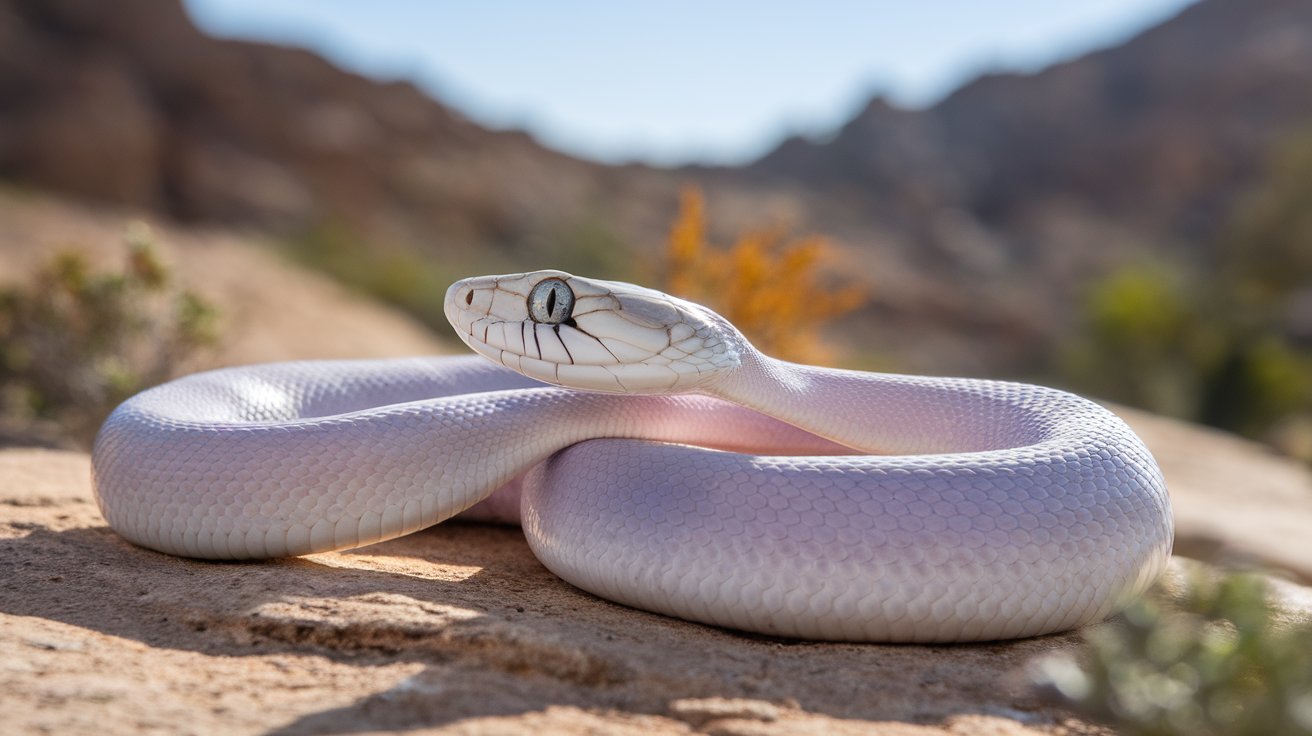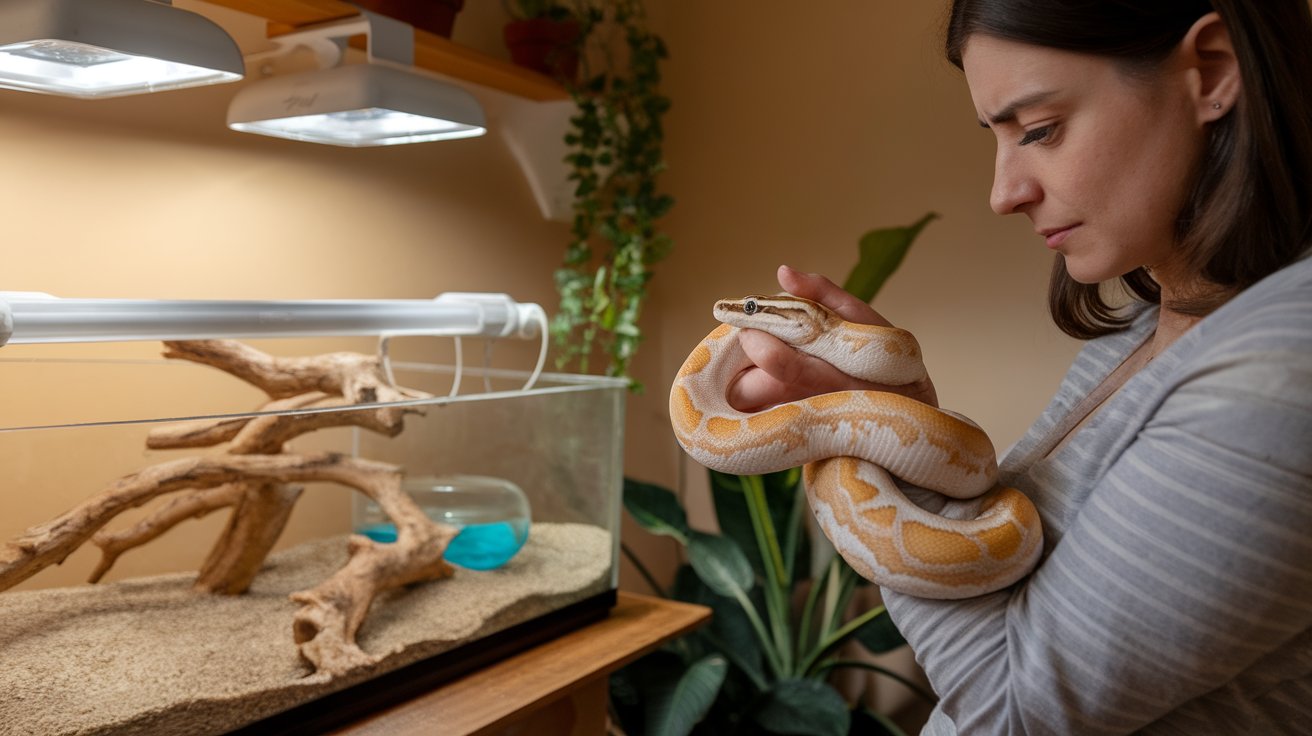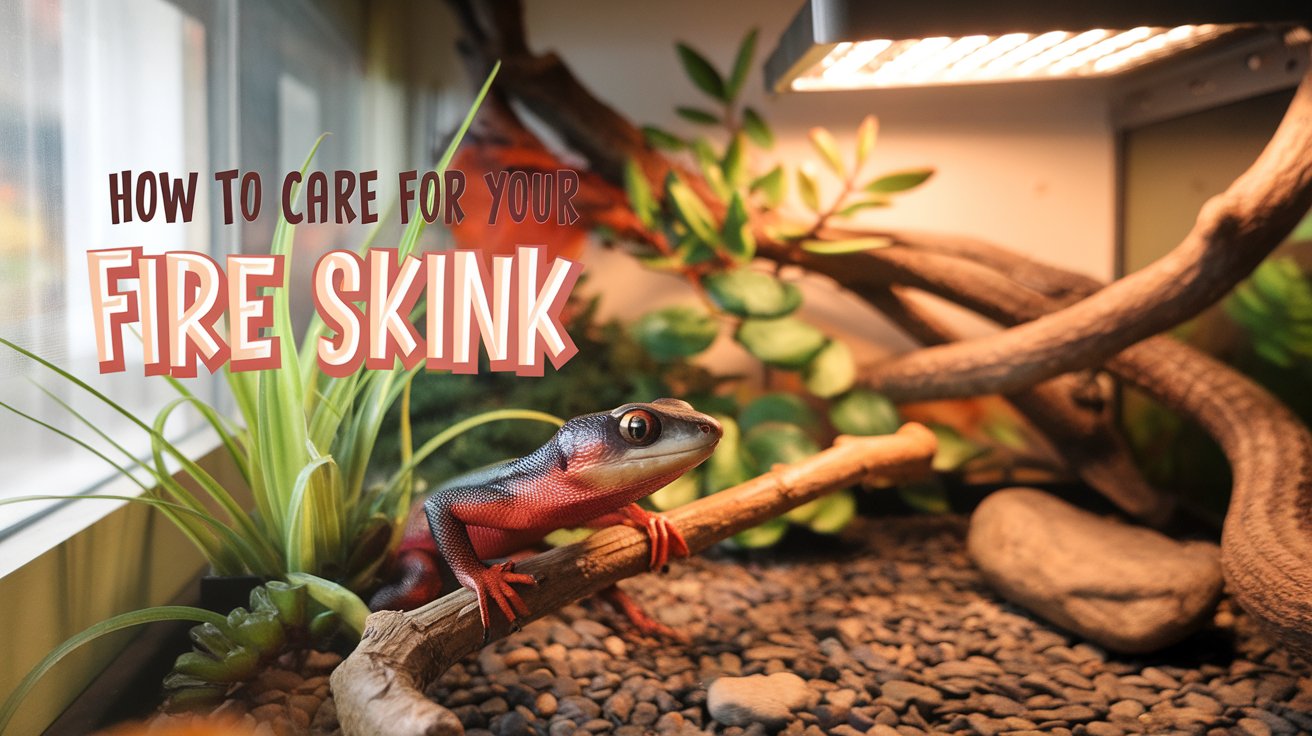Introduction
The panda hamster, known for its distinctive black and white coloration reminiscent of a giant panda, is a popular choice among hamster varieties, particularly the Syrian breed. These small rodents, often found in pet shops, appeal to both children and adults due to their cute round body and unique appearance. A panda hamster can grow up to 6 inches in length and has specific needs that potential owners should be aware of. They are nocturnal, making them ideal for those who are more active at night and can provide plenty of space to run.
Panda hamsters require an aquarium or cage with ample floor space to accommodate their active lifestyle. It is essential to equip their living environment with interactive toys and chew toys to keep them engaged and help maintain their dental health. Additionally, their diet should include pellet food formulas supplemented with fresh vegetables and occasional tasty treats. Understanding the unique characteristics and needs of the panda hamster will help ensure they live a healthy and happy life, avoiding issues like diabetes and obesity which can occur with improper care.
Key Takeaways
- The panda hamster, characterized by its black and white coloration, is a variety of the Syrian hamster that needs spacious enclosures to support its nocturnal lifestyle.
- These hamsters require a balanced diet of pellet food formulas enhanced with fresh vegetables and occasional treats to prevent health issues like diabetes and obesity.
- Proper hamster bedding, avoiding materials like cedar or pine, is crucial for their respiratory health and overall well-being.
- Panda hamsters exhibit unique behaviors, including burrowing and a preference for solitude, highlighting the need for individual housing to prevent conflicts.
- Enrichment activities such as tunnels and exercise wheels are vital for maintaining the mental and physical health of panda hamsters.
- Regular interaction and gentle handling can help panda hamsters become more sociable, although their natural inclination is towards solitude.
Understanding the Panda Bear Hamster
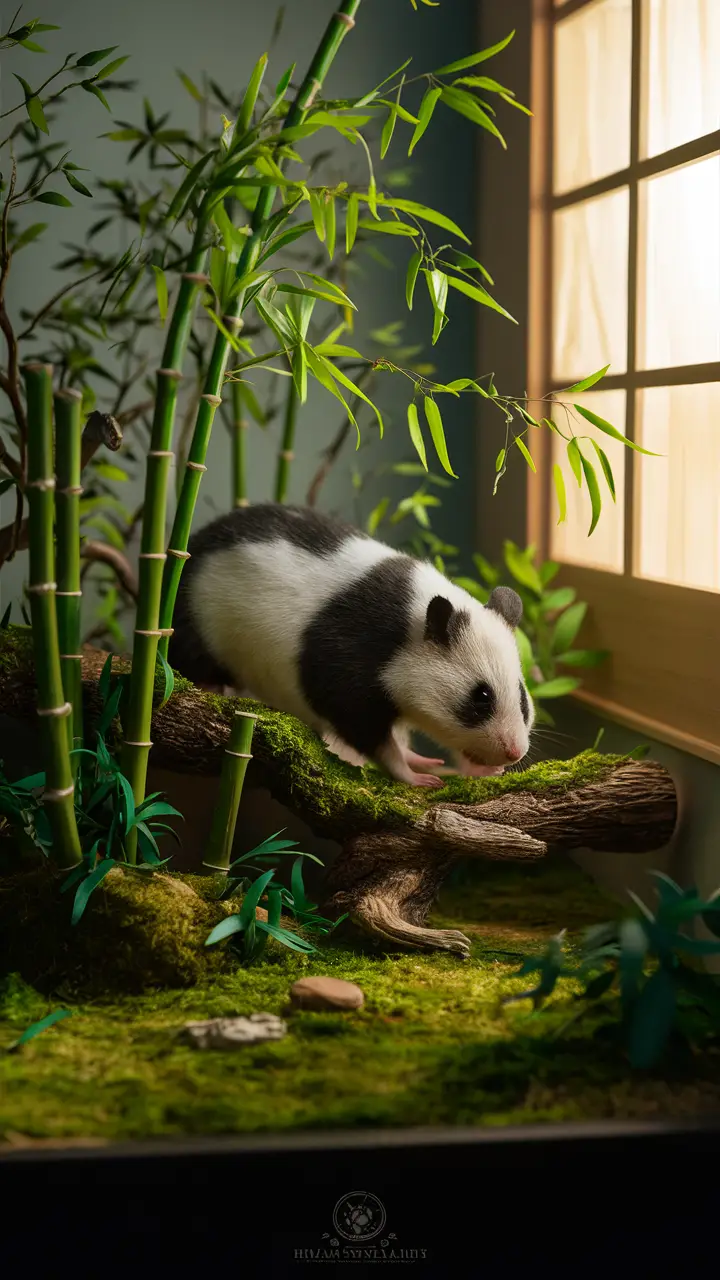
The panda bear hamster is a distinctive member of the Syrian hamster family, easily recognizable by its unique black and white coloration that mimics the appearance of a giant panda. This type of hamster can grow up to 6 inches in length and is nocturnal, making it a perfect companion for those who are more active during the nighttime. Their striking look and manageable size have made them a favorite among hamster enthusiasts.
Types of Hamsters: Is the Panda Bear Hamster the Right Choice?
Choosing the right hamster breed can be challenging, but the panda bear hamster stands out due to its visual appeal and larger size. Although these hamsters cherish their solitude and can be territorial, making them suitable for single-hamster homes, their presence can significantly enrich a pet owner’s experience. It’s crucial to provide them with ample space to thrive and avoid conflicts with other hamsters.
The Unique Nature of Panda Hamsters
Panda hamsters are known for their burrowing behavior and need for enclosures that include tunnels and other structures that support their instinctive activities. Unlike more aggressive breeds, panda hamsters are generally more docile, making them excellent pets if their environment is appropriately enriched. To foster a healthy lifestyle, owners should ensure these hamsters have varied activities and the ability to socialize within their space, although they are typically housed alone to prevent stress and aggression.
Panda Hamster Diet and Nutrition

Ensuring a panda bear hamster receives a balanced diet is crucial for its health and well-being. As the name suggests, their dietary needs are diverse, requiring a mix of commercial and fresh foods to obtain all the necessary nutrients. Overfeeding, particularly with treats, should be avoided to prevent health complications like obesity and diabetes.
Dietary Considerations for Maintaining the Health of Panda Hamsters
High-Quality Pellet Food: The foundation of a panda hamster’s diet should be high-quality commercial pellet food designed specifically for hamsters to ensure all nutritional needs are met.
Fresh Fruits and Vegetables: Supplementing their diet with a variety of fresh fruits and vegetables helps provide essential vitamins and minerals, enhancing overall health and vitality.
Controlled Treat Intake: While treats can be a nice addition, it’s crucial to control their quantity to avoid health issues such as obesity and diabetes, which are common in overfed hamsters.
Dental Health Practices: Providing chew sticks or hay helps maintain dental health, as these materials allow panda hamsters to naturally wear down their continually growing teeth.
Avoiding Harmful Foods: Sugary, acidic, and common human foods that are toxic to hamsters must be avoided to prevent dental problems and gastrointestinal disturbances.
This list aims to emphasize the importance of a carefully managed diet in influencing the behavior and temperament of panda hamsters, providing insights into how nutritional care impacts their overall well-being.
Essentials of a Balanced Diet
A balanced diet for a panda hamster should primarily consist of high-quality commercial pellet food, which is formulated to meet their nutritional needs. To complement this, adding fresh fruits and vegetables can enhance their diet’s nutritional value, ensuring they get a range of vitamins and minerals. It’s also important to provide materials such as hay or chew sticks, which help maintain dental health by allowing the hamsters to naturally wear down their continually growing teeth.
Foods to Avoid
Despite being omnivores, there are certain foods that should be excluded from a panda hamster’s diet. Sugary and acidic foods can cause serious health issues, including dental problems and gastrointestinal disturbances. Owners should ensure that fresh foods are given in moderation and are appropriate for hamsters, as certain common human foods can be toxic to them. Maintaining a varied but safe diet is essential for their long-term health.
Ideal Bedding and Enclosures for Panda Hamsters
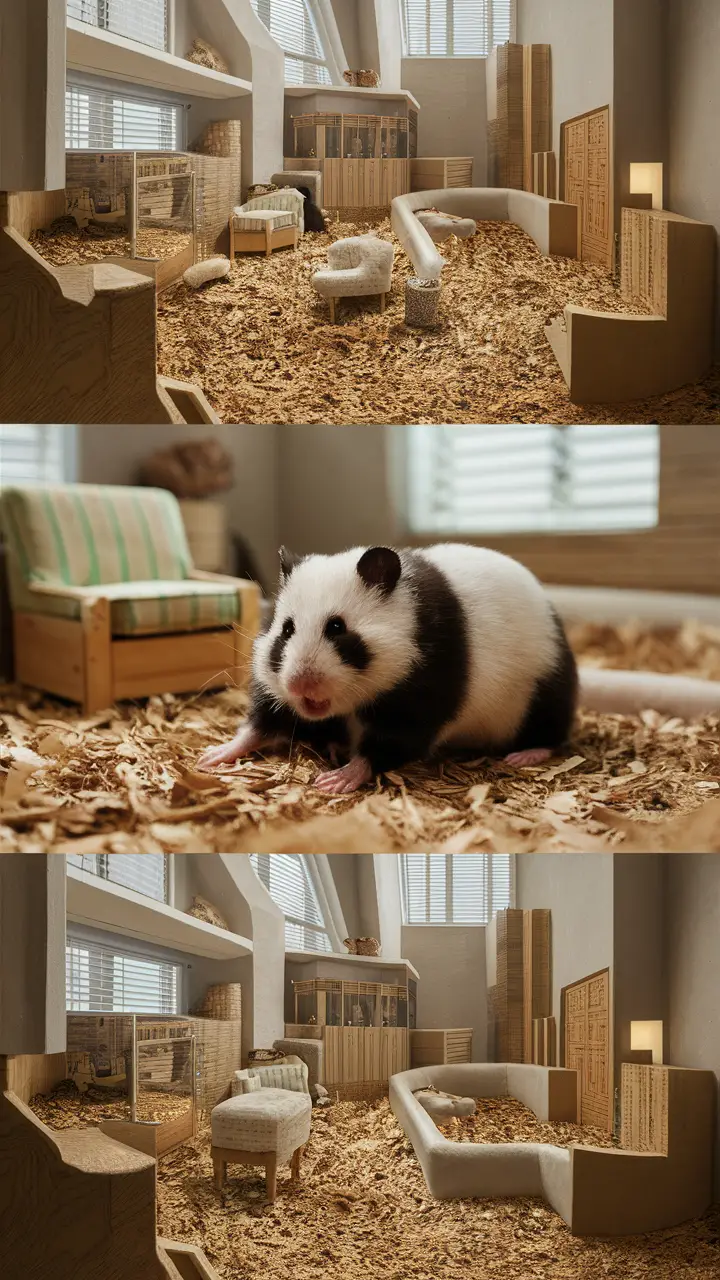
Creating the ideal environment for your panda bear hamster means using suitable bedding like aspen shaving and walnut to prevent respiratory problems. The cage should be spacious enough for exercise wheels and tunnels. Adding broccoli and various fresh foods to your panda bear hamster’s diet helps maintain their health. Additionally, ensure these hamsters have enough space in their nests and live in enclosures designed for their active lifestyle.
Choosing the Right Bedding
Among the various options available at pet stores, aspen is one of the safest choices for hamster bedding. It is crucial to avoid cedar or pine shavings, as they contain oils that can be harmful. Safe and comfortable bedding is essential for your hamster’s health.
Enclosure Specifications
An appropriate enclosure should be spacious and facilitate natural behaviors. Hamsters are nocturnal, so their habitats should include elements that cater to their activity patterns. Minimum dimensions of the cage should be at least 24 inches in length and 12 inches in height.
Behavior and Temperament of Panda Hamsters
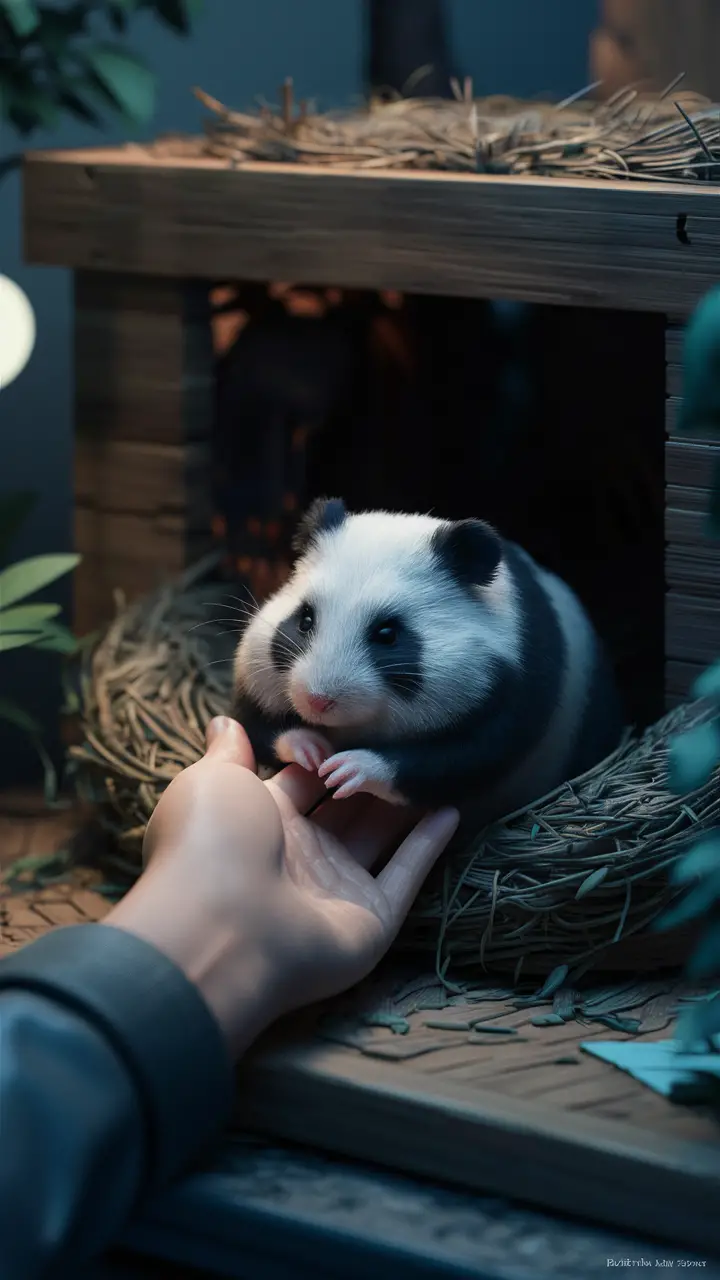
Panda hamsters are known for their distinct behavior and temperament, often preferring solitude to the company of other hamsters, which sets them apart from other breeds. These hamsters, typically living in one cage, also display unique social habits with humans, and it’s still important that you supplement their diet with many different fresh foods. Including celery, whole grains, and a variety of foods helps maintain their health, while their environment should allow for resting or sleeping peacefully.
Understanding Nocturnal Habits
As hamsters are nocturnal, they are most active during the night. This means they will do most of their playing, eating, and exploring when it’s dark. Owners should not disturb your panda hamster during the day to ensure they get enough rest.
Handling and Socialization
Handling your panda hamster gently and regularly can help it become more sociable. Despite this, it’s best to respect their preference for solitude when it comes to housing multiple hamsters. Understanding their unique behavior patterns can help improve their quality of life.
“Hamsters are often underestimated when it comes to their need for space and company. A solitary environment, while peaceful for many species, can thrive if properly managed and enriched.” – David Smallwood, an expert in small pet care and behavior.
Interesting Facts About Panda Hamsters
Panda hamsters are fascinating creatures with many amazing traits. Did you know that they can carry food in their cheek pouches and are sociable with humans? Their lifespan typically spans 2-3 years, and they thrive when provided with enrichment activities like tunnels and exercise wheels. These hamsters are often kept as pets and require a living environment that includes a nest box to prevent lethargy. Ensuring their well-being is crucial, and soiled bedding must be regularly replaced to maintain their health.
Physical Characteristics
The panda bear hamster is best known for its striking black and white coloration. Their fur pattern and coloration make them resemble panda bears. These small animals can grow up to several inches in length and have a stocky build.
Health Considerations
Maintaining a panda hamster’s health involves regular cage cleaning and a good diet. Lifespan can be maximized with proper care and diet. Regular vet check-ups are recommended to ensure they remain in the best of health.
Conclusion
In conclusion, the panda hamster offers a unique blend of charm and challenge that makes it a standout pet, especially among various hamster varieties sold at pet stores. These adorable creatures, with their striking black and white markings and round body, require specific care, including a balanced diet and proper enclosure to thrive. They need an environment rich in interactive toys and safe bedding like recycled paper or paper bedding, ensuring their nocturnal activities are supported and their health maintained.
Prospective and current owners should remember that panda hamsters are best housed alone due to their tendency to become irritable and aggressive if crowded. With regular, gentle handling, these hamsters can become tame and sociable, enhancing their interaction with humans. Ensuring they have a varied diet that includes pellet food, timothy hay, and occasional tasty treats like celery is essential for preventing health issues and enriching their lives.




